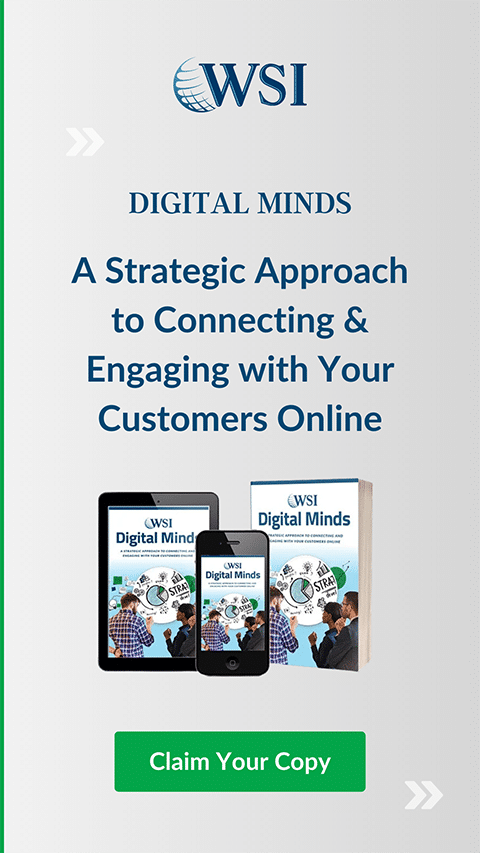Why the Customer Experience You Deliver is Vital in A Digital World
Jan 22, 2021 | 10 MINUTES TO READ

Summary: A good customer experience can transform dissatisfied customers into enthusiastic ones. This post dives into what you need to know to delight your customers and improve your business's bottom line.
Businesses, whether online via eCommerce or in physical space, are always facing human beings. People are who we are selling to, who we are delivering products to, and who we are providing service to. The human element of business has always made developing relationships with customers essential, just as real estate agents have always made an effort to make empty, on-the-market homes feel homier (using tricks like baking cookies).
Although the increasingly virtual nature of business has reduced face to face contact with one’s customers, it’s crucial to remember that people are still people when they’re interacting with your business through their laptop’s screen.
Thinking about customer experience, the thoughts and feelings a customer has while interacting with your brand is a great way to continually remind yourself that many different individuals see your online presence.
What is Customer Experience?
Simply put, customer experience is the sum total of everything that goes through a customer’s mind throughout interacting with your business. It’s not about any one stage of business—just buying a product or using it. Instead, every moment that a customer’s attention is on your brand in any way is a part of their experience.
Customer experience (or CX) then is a big concept with a lot of complexity. There’s both a lot of different ways a customer interacts with a business and many types of potential reactions.
To start with an offline example, think about someone walking into a store at the mall. Perhaps it’s a clothing store like the Gap or the Banana Republic. What the customer first looks at is part of their experience, as is what they hear and what they smell. They start to look for the section relevant to them: is it clearly labeled or not so, leaving them with a sense of confusion. How do the employees give them directions?
This description could go on and on because people have complex thoughts and emotions while doing anything—even shopping for jeans.
After all, customer reactions are just as rich and complex when buying jeans online in an eCommerce model. Each moment a person spends on a website, or a brand’s social media, is a moment they think about, feel, and interpret.
The experience they’re left with is one that will determine not only whether they return to your website but also whether they leave a glowing or disparaging review, whether they recommend it to their friends or mock the awkward web design.
The goal of customer experience is to create positive experiences that make a person want to come back to your site. In the end, it’s all about building customer loyalty.
Understanding the Customer’s Journey Through Your Service
As described above, CX might seem too big and complicated to get a grip on. How could someone think about every moment of every interaction a customer has with their business? How can one tiny moment or detail impact a client’s perception of your brand?
It can be done relatively quickly, in fact, by breaking down the way a customer moves through your online presence. This is called the ‘customer’s journey,’ and will help you identify stages where improving the customer’s experience will be easier.
Think about it as a set of directions on Google maps. At the start might be the moment your website loads. There’s the landing page, which your customer will scan and react to. Then, probably, they have to find a section they’re interested in, and finally make a selection. But of course, they also need to pay for any product they choose, so the payment system is crucial too.
A simple website might have a customer journey that looks like this:
landing page → product category → specific product → payment
Other types of businesses will have outlines that look very different, but they can be made in the exact same way.
Each stage of the customer’s journey must give them a good experience. But, equally important is the transitions between the different stages. It should be clear and easy to move forward. For example, once a customer has found a product they love, it shouldn’t be hard to find the buy now button.
Nowadays, customers have have high expectations for ease of service, which leads us to design—one of the most critical factors in virtual customer experience.
Great Design Makes a Great Customer Experience
Design structures a customer’s interaction with a website to a more direct degree than anything else. In this context, the design doesn’t just mean the way a website looks, but also how it’s structured and how well it runs. And how well it runs on mobile, too, as more and more people are using smartphones to interact with businesses.
Visual Aspects of Design
Since humans are visual creatures, we can’t help but react to the aesthetic choices made on a web page. An ugly website isn’t doing your business any favors.
However, once you’ve ensured your page isn’t actively ugly, there are still many choices to be made. Most of which will go back to brand identity. Your website’s look should give the viewer an experience consistent with how your company presents itself. Is it young and fun (perhaps use bright colors and exciting fonts) or more conservative and responsible (then a more neutral palette is called for, and an established font like Times New Roman)?
Finally, be sure that the visible aspects of your website are consistent with your offline brand identity. Your website’s experience can be its own form of marketing for your entire business.
The Construction of the Website
The way that a customer moves through a website is also an important aspect of design. What options are presented on each part of your website? Putting everything upfront might create an overwhelming experience, but hiding too much can be just as frustrating. The moments that a user spends looking for something ruins their experience of your website.
Make sure there’s a logical progression. Indeed, in the best-case scenario, the customer shouldn’t even need to really think about where to navigate next. If the next step is salient, it’s almost automatic to click on it. Creating a customer experience that’s so easy and seamless that it becomes automatic holds many benefits for customer loyalty as anything else.
Interaction is Key
The internet has made customers more than just passive recipients of information. Customers have become used to shaping what they see and interacting with that content. Twitter and Facebook have trained us to expect to be able to express an opinion, and we’ve also gotten used to only seeing the information we want to see.
A customer able to interact with a brand and actively shape their experience feels that sense of empowerment when the transaction concludes.
There are many ways to deliver this expanded role to your customers. One great way is to create the option of making profiles that will ensure their choices carry over from one session to the next. If they decide they only want to see one type of product, respect that — if not, annoyance will quickly follow.
Another option is to allow customers to ask questions and make requests to chatbots, a technology that allows for instant answers. Giving customers the ability to receive instant answers can change a confusing experience into one that features a quick resolution to a problem.
Finally, not all features of your website have to be so high tech. In-person events can be done via an online format quite easily. Training sessions take the form of webinars, and formerly live promotional events can be live-streamed or recorded. These aspects of customer experience provide them with value and give them a reason to come back.
The Importance of Collecting Feedback
Feedback is crucial to developing a good customer experience for two main reasons.
First of all, offering your customers the chance to give feedback on your service can be a positive aspect of customer experience all on its own.
If your customer has a problem or something they don’t like about your service, they have a way to express those negative feelings. By doing so, they provide an opportunity for you to address their needs. After that, you can begin making amends for that particular client and then change the CX moving forward. A positive experience can also be reinforced and become more memorable when recorded on a feedback form.
Secondly, feedback gives a company a great idea of where their customer experience needs to be improved. There’s no better source of information than the customers themselves, as they are the group you are trying to provide with a good experience. No matter how good your web design team considers itself, it’s impossible to precisely know how people will react to a website.
It’s also essential to collect quality feedback. Just asking broad questions — how was your experience today? — will not give much direction about what needs to be improved. Instead, it’s important to ask about the specific stages of the customer’s journey. That will tell you exactly where improvements are necessary.
Analyzing and Using Feedback
The customer feedback, once collected, is an excellent source of data. But, data is only as good as the analysis you do on it. In other words, figuring out what information means is the real key to unlocking its value.
First, figure out which aspects of customer experience are relevant to a particular piece of feedback. One part of a website might be getting glowing reviews, telling you that improvements are more prudent elsewhere.
That said, one thing to keep in mind is the transitions between different parts of your online presence. It might be that one web page doesn’t seem to be the problem but doesn’t display crucial information necessary for the next step of the customer journey. Thus, you can’t just focus on each part totally in isolation.
Training workers from all departments of your business in data analytics is crucial because, as has been a theme, all aspects of a company are involved in the customer experience. If data isn’t going where it needs to go, it can’t have the best possible customer experience effects.
Also, the different departments will contain people with different backgrounds and skillsets. Getting the eyes of many diverse team members on the data you’ve collected will generate insights that no one group could’ve reached on their own.
Your Website Doesn’t Stand Alone
Finally, it’s essential to realize that your web page is just one part of your business. It exists in the context of your business as a whole and must remain consistent with everything else.
A bad product with a good website is still just a lousy product.
Bad customer service through a good website is still miserable customer service.
The main way to avoid these sorts of mismatches is to remain consistent across your entire business. Doing so lets your customer experience act as a direct form of marketing, reinforcing messages about why your business is the best.
Wrapping Up
As this tour through customer experience has shown, few things are as expansive and crucial to a business’s bottom line as customer experience. The entirety of a person’s engagement with your business must be thought about meticulously. But, when you find opportunities for improvements, the impact on business can be vast and immediate. Dissatisfied customers can transform into enthusiastic ones.
The way to get inside the customer’s mind is to think about your business’s different stages. If you think about what they are thinking and feeling, you’re sure to make improvements.
If you would like to learn more about how to make your business’ customer experience more of a stroll and less of an odyssey, we’d love to chat with you right now!
Don't stop the learning now!
Here are some other blog posts you may be interested in.
VIEW ALL BLOG POSTS-
Why the Customer Experience You Deliver is Vital in A Digital World
Businesses, whether online via eCommerce or in physical space, are always facing human beings. People are who we are …
READ MORE -
How to Grow Your Business with Online Reputation Management
Want more positive online reviews for your business? The recent webinar hosted by WSI’s Carlos Guzman covered online reputation management and, ICYMI, you can view …
READ MORE -
Why Buyer Personas are Important and How You Can Create Your Own
Do you know exactly what your ideal customer looks like? You should! Building accurate and detailed buyer personas is key to …
READ MORE









